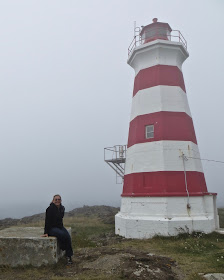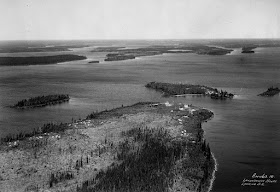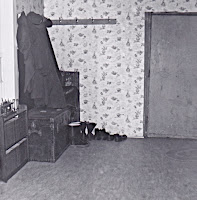about a third of what you are saying to them,"
my father wrote in a letter from Lansdowne House in early 1961.
"I nearly drove myself up the wall today trying to teach one of my beginners
to recognize the largest of a series of numbers and to mark it.
I just couldn’t get it across to her what I meant by big and small..."
Typing a Letter Home
Donald MacBeath, Lansdowne House
Northern Ontario, Canada, 1961
© M. Louise (MacBeath) Barbour/Fundy Blue
As a teacher in a one-room Indian day school,
my father frequently faced challenges like this.
He was referring to a kindergartner and math in this instance,
but the complexities of concepts and of academic English
increased at every grade level and occurred in all subjects.
Consequently he dealt with such difficulties frequently.
My father never considered these stumbling blocks
a question of the intelligence or capability of his Ojibwa students.
He placed the solution squarely on the shoulders of the teacher:
"The success or failure of the teacher's efforts depends upon his ability or inability
to adapt the textbooks and curriculum to the pupils and the situation."
I vividly remember my father handling the challenges
of teaching his students to identify money
and to understand transactions
like paying for an item and counting change.
These concepts were part of the math curriculum
for each of his six grades in April, 1961:
from me, the only student in grade five,
to my sister Barbie, the youngest kindergartner,
to all the Ojibwa students and two of my siblings in between.
Canadian Change
How do you teach young students the concept of money
when they understand only the rudiments of your language
and have little or no experience with money?
My brother and I could certainly identify Canadian coins and bills,
and we had already had small jobs and had done things
like pay to go a movie or buy ice cream at a store.
The Ojibwa students knew only the Hudson's Bay Company post
and a couple of tiny indigenous stores,
one on the island and one on the mainland.
The Bay's system of trading debt for furs their fathers trapped in the bush
was unlike anything depicted in their textbooks.
While my sisters Donnie and Barbie might not grasp
adding amounts over a dollar or making change,
they had watched my father counting money many times.
Many evenings he would empty his wallet, change purse, and pockets
and lay out his money on the kitchen table.
Then he would sort the coins into meticulously-formed dollar stacks,
tunelessly whistling as he did so.
We kids used to joke among ourselves as we watched this daily routine,
"The king is in his counting house counting all his money."
Unlike us, a number of the younger Ojibwa students
had likely never touched money,
nor seen it sorted out into stacks of coins and bills.
When my father tackled money and its use with his students,
he quickly realized that textbooks, paper, and blackboards were not working,
especially for his kindergarteners and younger students.
He also recognized that everyone needed more practice handling money
and a greater understanding of how money worked in Canadian society.
So one memorable afternoon, my father scrapped the regular curriculum
and announced, "This afternoon we're going to be counterfeiters!"
Familiar Bills from My Childhood
After explaining what he wanted us to do,
and the fact that we were not going to be real counterfeiters,
my father had us push back all the desks and chairs,
cover patches of the floor with old newspapers,
and get out paper, pencils, scissors, and paint.
At first it was quiet and calm,
as students began drawing coins and bills,
using templates my father had made over the lunch break.
However, as they became more absorbed
in adding denominations to the larger-than-life coins
and sketching pictures on the bills, chatter broke out.
Soon scissors were snipping, paint was slapping,
and the laughter and voices of excited children filled the room.
 |
| ebay |
Some children took particular delight
in drawing the beaver
on their counterfeit nickels,
because the animal was more familiar
to them than the nickel.
Others had fun drawing their "counterfeit" bills,
especially the forest and river scene on the back of the five dollar bill,
the most similar landscape to theirs.
The Back of the Five Dollar Bill
The 1954 Canadian Landscape Series
As we finished our coins or bills,
we laid them out on desks pushed near the windows.
It was bright and sunny outside,
and sunlight poured into the classroom,
quickly drying the damp papers scattered about.
After the activity was done and the classroom restored to order,
my father announced that when we returned to school the next day
things were going to be very different.
We all scattered to our homes filled with laughter and energy,
after an unexpected afternoon as counterfeiters.
A Child Paints
We four MacBeath kids didn't know any more than our curious Ojibwa classmates.
Despite all our questioning, pleading, and needling,
Dad had revealed nothing over the supper table the previous night.
He didn't keep his pupils waiting for long.
After roll call, my father said: "For the next few weeks
we're operating strictly on a cash basis at school.
I will pay each of you a salary,
using the money we made yesterday.
A salary is money you earn by working at a job,
and your job is coming to school to learn."
He went on to explain in simple terms
how we would have to pay rent for our houses
(our desks and chairs) and buy food (our milk and biscuits)
out of the salaries we earned each week.
We could earn extra money by doing chores in the classroom,
and we could earn prizes by scoring 100% on a test
or improving at something we were learning.
Then he hooked us with a big juicy worm:
"Whoever has the most money at the end of each week
will earn a real one dollar bill!"
That was serious money!
It took me four weeks of multiple chores a day,
like hauling water, dumping the chemical toilet,
and fetching groceries from the mail plane, to earn a dollar.
Roy and I locked eyes immediately,
each signaling to the other that he or she was going to win.
Of course, all around the classroom kids were thinking
that they would be the one to win a real dollar.
Rivals from the Beginning
(This Time Blowing Bubbles)
Smith's Cove, Nova Scotia, Canada
© M. Louise (MacBeath) Barbour/Fundy Blue
My father tacked a list of favorite activities on the wall up front
and told us we would have to pay for certain school activities,
like swinging on the swings at recess (15 cents)
or playing a game of war when our work was done (25 cents).
He added a list of chores that we could do to earn money,
such as erasing the blackboards (10 cents per front or side board)
or knocking chalk dust out of the erasers (15 cents).
Then he pulled out his personal cashbox
which he had stocked with bills from our Monopoly game at home.
He explained that this was the bank and a bank needed lots of money,which he had stocked with bills from our Monopoly game at home.
so he was adding Monopoly money to our stash of "counterfeit" bills.
He started each of us off with twenty dollars,
the younger children with a combination of ones and fives,
and the older kids with a green $20.00 Monopoly bill.
This represented money we had saved, he told us,
and would tide us over to our paycheck on Friday
at the end of the following week.
Monopoly Money
We would each earn $20.00 a week,
and our rent of $6.00 and our food bill of $4.00
would be due each Friday,
leaving us $10.00 to spend as we pleased.
He appointed one of the elder kids Banker for the Day,
and any time we needed to pay for something
we had to go to the bank to do so,
counting out the money involved in the transaction.
The challenge was on!
We began with my father matching us up in pairs
to practice identifying and counting coins and bills
appropriate to our grade level and skills.
My father ensured that at least one of each pair
had the knowledge to help the other with the task.
Day by day, we spent time practicing,
as my father adjusted the pairs and tasks according to need.
As the simulation unfolded, so did the strategies.
Some pupils were savers and others were spenders.
Some were entrepreneurs who went into business
by suggesting to my father that they could grade papers
or do other things not on the chore list he had tacked up.
My father generously passed out pennies and nickels
for desired behavior and good work
and collected fines for infractions of the classroom rules.
On Friday afternoon it cost us twenty-five cents
to buy a bingo card and participate in the weekly games.
We could buy a second card for twenty cents,
a very attractive offer since the winner of each game
won a chocolate bar which my father had bought at the Bay.
Classic Bingo
For my brother Roy and I, there was an extra twist
to the quest to win a dollar the first full week.
Dad had overheard us one evening betting on the outcome.
Roy bet that he'd beat me, and I bet that I'd beat him.
"Are you going to back your bets with real money?" Dad asked.
He often said that when he caught us betting.
We each bet twenty-five cents, a week's allowance.
Dad marked the bet in his notebook,
and Roy and I eye-battled with each other,
each confident in our ability to beat the other
and reap the riches.
It was a close battle among the school kids as the days sped by,
and a tighter battle between Roy and me with our side bet.
I was holding my own, until one ghastly moment
when my father stopped by me and leaned in to check my work.
"Damn-it-all, Louise, you stink!
How many times do I have to tell you
you are older now and have to wear deodorant!
You owe me five dollars right now
for stinking up the classroom!"
I forked over the demanded five, chagrined.
"Now go home and don't come back,
until you've washed and put on deodorant."
I slunk out the school door.
I fumed all the way home through the bush.
I knew my father had been reminding me for days
to use deodorant ~ a new development in my life.
I knew his socks were lined up like soldiers on parade in his drawer.
I knew that he spit-shined his shoes every Sunday
and wore a suit and tie to school every day.
I knew that he said you couldn't let yourself go in the bush.
I knew that he always wore deodorant.
I knew that I had forgotten deodorant ~ again.
Was I fuming because he had humiliated me in front of the class?
No.
I was furious about the knowing smirk Roy flashed me on my way out.
I was going to have to pay up a real quarter to him.
My father arrived home not long after,
having unexpectedly dismissed everyone for lunch early.
He took me quietly aside and returned my five dollars.
He told me that he felt terrible about what he had done,
and that he never should have said what he said
in front of all my classmates.
It was one of the rare times in his life
that he apologized to me for something,
and I never forgot it.
I can't remember who won the coveted dollar each week.
Guaranteed it wasn't one of us MacBeath kids,
because my father felt we had more than enough,
and rightly or wrongly, he would have found a way
to ensure that an Ojibwa pupil won each time.
I don't remember who had to pay the humiliating bet,
Roy to me, or me to Roy.
It wasn't the only time one or the other had to pony up,
as we grew up rashly making bets.
Whenever my father caught us,
he would make sure the loser paid,
invariably reminding us that we could never welch on a bet.
Everyone learned lots about money and something about hygiene.
As for me, I've rarely forgotten my deodorant since!
Dad's Pupils Dunking for Apples
and practicing their English
Photo by Don MacBeath
© M. Louise (MacBeath) Barbour/Fundy Blue
Till next time ~
Fundy Blue
Crossing Petite Passage
Bay of Fundy, Nova Scotia
Photo Copy by Roy MacBeath
© M. Louise (MacBeath) Barbour/Fundy Blue
All Rights Reserved
Notes:
1. Letter: January 18, 1961
2. Unpublished Handbook:
Recorded in Dad's unpublished The Northern School Teacher: A Hand Book To Be Issued To All
New Entrants To The Teaching Profession In The Indian Schools In The Sioux Lookout Indian
Agency, 1966, page 14.
3. The king is in his counting house:
This is from a line from a nursery rhyme we all knew called "Sing a Song of Sixpence."
4. Milk and Biscuit:
Twice a day every student had a snack of powdered milk and vitamin biscuits provided by a
government nutrition program.
5. Game of War:
This is a card game that my father taught his students to play. The objective was to win the entire
deck of cards. It involved students being able to recognize larger, smaller, and equal numbers,
and they had to practice English while playing. How to play War
As a teacher, my father tried to make learning fun and to add incentives for his Ojibwa students
to practice speaking English.
6. Bingo:
On Friday afternoons my father set aside some time to do activities like singing songs and
playing bingo. The purpose was to encourage his Ojibwa students to overcome their shyness,
to speak in English, and to have fun while learning.
When I became an elementary teacher myself, I drew a lot on what I had learned from my father
so memorably during grade five and later in grade eleven. I used many of his ideas and techniques
with my own students.
For Map Lovers Like Me:
Location of Lansdowne House
Known Today as Neskantaga
Location of Lansdowne House
Wikimedia edited
Full context of the quote from my father's January 18, 1961 letter:
"It is awfully hard to teach children when they only understand
about a third of what you are saying to them.
I nearly drove myself up the wall today trying to teach one
of my beginners to recognize the largest of a series of numbers and to mark it.
"I just couldn’t get it across to her what I meant by big and small.
I finally got it across by using about three sheets of foolscap
and putting down about twenty-five series of numbers.
"Alongside each number, I would put a group of dots corresponding to the number.
After I finished each series, I would count the dots after each number
and cross out the number having the largest group of dots.
"After each series, I’d draw another series and see if she could do it;
and if she couldn’t do it, I’d repeat the whole process.
She finally caught on to it at the twenty-third series of numbers.
By this time I was really seeing dots before my eyes.
"I wonder how many series I’ll have to draw next week when I
attempt to teach her to recognize and mark the smallest number."








































